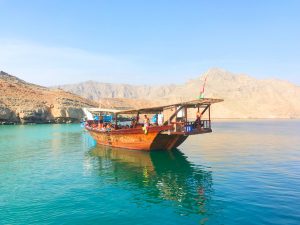The Sultanate of Oman is a country on the southeastern coast of the Arabian Peninsula, bordering Saudi Arabia and the United Arab Emirates to the north and Yemen to the west. The Arabian Sea and the Gulf Oman run along its coastline and it has a strong maritime history. It is a country rich in natural beauty and culture. It is budget- and family friendly, and a very safe tourist destination.

A Musandam dhow, Oman
In the north of Oman, you can witness expansive landscapes of undulating, golden sand. Elsewhere, the barren landscape is punctuated by picturesque wadis – green corridors of flowing water that run through canyons, forming gushing waterfalls with emerald and turquoise pools surrounded by date palms. Another iconic spot is the Bimmah Sinkhole, a natural 90m deep blue hole with crystalline water, ideal for daring cliff jumps.
The tourist industry accounts for 2.5% of GDP and 3.500.000 million tourists visited Oman in 2019, but the arrival of COVID from Iran on 24 February 2020 changed all that. The vast majority of cases occurred in the expatriate community of Muscat, and the entire governorate was put under lockdown until 29 May 2020. Over 7.500 people were put under home quarantine in the month of March alone. Various regional and national level lockdowns have been imposed since. Flights were suspended with high risk destinations as early as 9 March, and by 29 March all international flights were put on hold.
The first major spike was over by July 2020, and Oman reopened its airports on 1 October with mandatory testing and quarantine restrictions in place for incoming travelers. There have been subsequent spikes in April and July 2021, and total confirmed cases so far have reached 300,000, with 4,100 deaths. Oman is ranked at 89 in the list of countries with the highest death rate per capita, although excess deaths suggest the government has underreported this by over 80%. 45% of Omanis are currently fully vaccinated. Current entry requirements include proof of full vaccination, a negative PCR test result, and health insurance. Further information can be found here: Oman Airports – entry requirements![]() .
.
Due to the strict and delayed entry regulations, our Oman liveaboard safaris have been suspended until 27 August 2022. The opportunity was taken to put the yacht in dry dock for extensive renovations and improvements. Once operations resume, Oman scuba divers will have the choice of exploring the Daymaniyat Islands off the coast of Muscat, or the Hallaniyat Islands in southern Oman. The seas are full of life, with whale sharks, humpback and sperm whales, dolphins, manta and mobule rays, sharks, turtles, mola mola, king mackerel, tuna, as well as moray eels, angelfish, stingrays, lobster and crayfish, and nudibranchs. More than 1,000 different types of fish and shellfish are home in the Arabian Sea and Gulf of Oman. Strict fishing conditions and large marine parks ensure that this valuable treasure remains well protected.